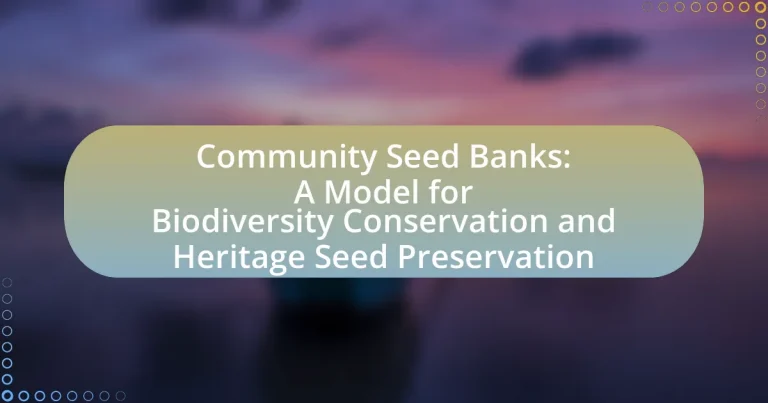Community seed banks are local repositories that preserve diverse plant varieties, particularly those that are culturally significant or at risk of extinction. They play a vital role in maintaining agricultural biodiversity and heritage seeds, involving local farmers and communities in the processes of seed collection, storage, and sharing. This article explores the functioning of community seed banks, their importance for biodiversity and local agriculture, the challenges they face, and best practices for establishing and sustaining these initiatives. It highlights the significance of heritage seeds, the benefits they provide to local farmers, and the impact of community engagement on the success of seed preservation efforts.

What are Community Seed Banks?
Community seed banks are local repositories that store seeds of diverse plant varieties, particularly those that are culturally significant or at risk of extinction. They serve as a means to preserve agricultural biodiversity and heritage seeds, ensuring that traditional varieties are maintained for future generations. Community seed banks often involve local farmers and communities in the collection, storage, and sharing of seeds, fostering a sense of ownership and responsibility towards biodiversity conservation. This model has been recognized for its effectiveness in promoting sustainable agriculture and resilience against climate change, as it allows communities to adapt their crop choices to local conditions and preferences.
How do Community Seed Banks function?
Community seed banks function by collecting, preserving, and distributing seeds within local communities to promote agricultural biodiversity and food security. These banks operate through a collaborative model where community members contribute seeds, often traditional or heirloom varieties, which are then stored under controlled conditions to maintain viability.
The process typically involves community engagement in seed selection, cultivation, and sharing, ensuring that local agricultural practices and preferences are respected. Research indicates that community seed banks enhance resilience against climate change and contribute to sustainable farming practices by maintaining genetic diversity. For example, a study published in “Agriculture and Human Values” highlights that community seed banks empower farmers by providing access to diverse seed varieties, which can improve crop yields and adaptability.
What processes are involved in seed collection and storage?
Seed collection and storage involve several key processes: harvesting, cleaning, drying, and packaging. During harvesting, seeds are collected from mature plants at the right time to ensure viability. Following this, cleaning removes debris and contaminants, which is crucial for maintaining seed quality. Drying reduces moisture content to prevent mold and decay, typically achieving a moisture level of around 5-7%. Finally, packaging in airtight containers protects seeds from environmental factors, ensuring long-term storage viability. These processes are essential for preserving genetic diversity and ensuring the availability of seeds for future planting.
How do community members participate in seed banking?
Community members participate in seed banking by collecting, preserving, and sharing local seeds to maintain biodiversity and cultural heritage. They engage in activities such as seed saving, where individuals harvest seeds from their crops and store them in community seed banks, ensuring the availability of diverse plant varieties. Additionally, community members often participate in workshops and training sessions to learn about seed preservation techniques and the importance of genetic diversity. Research indicates that community seed banks enhance local food security and empower communities by fostering collaboration and knowledge sharing among members, as seen in various successful initiatives worldwide.
Why are Community Seed Banks important for biodiversity?
Community seed banks are crucial for biodiversity because they preserve a wide variety of plant genetic resources that are essential for food security and ecosystem resilience. By maintaining local seed varieties, these banks help protect against the loss of genetic diversity caused by industrial agriculture and climate change. Research indicates that community seed banks can enhance agricultural resilience by providing access to diverse seeds that are better adapted to local conditions, thus supporting sustainable farming practices and promoting ecological balance.
What role do they play in preserving local plant varieties?
Community seed banks play a crucial role in preserving local plant varieties by collecting, storing, and distributing seeds that are adapted to specific local environments. These banks ensure genetic diversity and safeguard traditional agricultural practices, which are vital for food security and resilience against climate change. Research indicates that community seed banks can maintain over 1,000 local varieties, thus contributing to the conservation of biodiversity and cultural heritage. For example, the Global Forum on Agricultural Research highlights that community seed banks have successfully preserved unique varieties that might otherwise be lost due to industrial agriculture’s focus on a limited number of high-yield crops.
How do they contribute to ecosystem resilience?
Community seed banks contribute to ecosystem resilience by preserving genetic diversity and ensuring the availability of diverse plant species for future cultivation. This genetic diversity enhances the adaptability of ecosystems to changing environmental conditions, such as climate change and disease outbreaks. Studies have shown that diverse plant populations are more resilient to stressors, as they can provide a wider range of traits that may be beneficial in fluctuating environments. For instance, research indicates that agricultural systems with higher crop diversity can better withstand pests and diseases, leading to more stable food production and ecosystem health.
What challenges do Community Seed Banks face?
Community Seed Banks face several challenges, including funding limitations, lack of technical expertise, and issues related to seed quality and diversity. Funding constraints hinder their ability to maintain operations and expand their collections, as many rely on grants and donations that may not be consistent. Additionally, the lack of technical expertise among community members can lead to difficulties in seed preservation and management practices, which are crucial for maintaining genetic diversity. Furthermore, ensuring seed quality is a persistent challenge, as contamination and loss of viability can occur without proper storage and handling techniques. These challenges collectively threaten the effectiveness of Community Seed Banks in conserving biodiversity and preserving heritage seeds.
What are the financial and logistical obstacles?
Financial and logistical obstacles in community seed banks include limited funding, high operational costs, and challenges in seed storage and distribution. Limited funding restricts the ability to acquire necessary resources, while high operational costs, such as facility maintenance and staff salaries, can strain budgets. Additionally, logistical challenges arise from the need for proper seed storage conditions, transportation issues, and the coordination of volunteer efforts, which can complicate the effective distribution of seeds to local farmers. These obstacles hinder the sustainability and effectiveness of community seed banks in promoting biodiversity conservation and heritage seed preservation.
How do climate change and urbanization impact their effectiveness?
Climate change and urbanization significantly reduce the effectiveness of community seed banks in biodiversity conservation and heritage seed preservation. Climate change alters growing conditions, leading to shifts in plant phenology and increased vulnerability to pests and diseases, which can diminish the viability of seeds stored in these banks. Urbanization, on the other hand, often results in habitat loss and fragmentation, reducing the genetic diversity available for conservation efforts. Studies indicate that urban areas can experience a decline in native plant species, which directly impacts the genetic resources that community seed banks aim to preserve. For instance, research shows that urbanization can lead to a 50% reduction in native plant diversity in some regions, thereby limiting the effectiveness of seed banks in maintaining local biodiversity.

How do Community Seed Banks promote Heritage Seed Preservation?
Community Seed Banks promote Heritage Seed Preservation by collecting, storing, and sharing traditional seed varieties that are often at risk of extinction. These banks serve as repositories for local seeds, ensuring that genetic diversity is maintained and that farmers have access to heritage varieties that are adapted to local climates and conditions. Research indicates that community seed banks not only safeguard these seeds but also empower local communities by fostering knowledge exchange and encouraging sustainable agricultural practices. For example, the Global Forum on Agricultural Research highlights that community seed banks have successfully preserved thousands of traditional seed varieties, thereby contributing to food security and biodiversity conservation.
What is the significance of heritage seeds?
Heritage seeds are significant because they preserve genetic diversity and cultural heritage in agriculture. These seeds are open-pollinated and have been passed down through generations, ensuring that unique varieties adapted to local climates and conditions are maintained. The preservation of heritage seeds supports biodiversity, which is crucial for food security and resilience against pests and diseases. According to the Food and Agriculture Organization, over 75% of crop diversity has been lost since the 1900s, highlighting the importance of heritage seeds in combating this loss and promoting sustainable agricultural practices.
How do heritage seeds differ from commercial seeds?
Heritage seeds differ from commercial seeds primarily in their genetic diversity and cultivation practices. Heritage seeds, often referred to as heirloom seeds, are open-pollinated varieties that have been passed down through generations, maintaining their genetic integrity and adaptability to local conditions. In contrast, commercial seeds are typically hybrid varieties developed for uniformity, higher yields, and resistance to pests, often requiring specific agricultural inputs.
Heritage seeds promote biodiversity and resilience in ecosystems, as they can adapt to changing environmental conditions, while commercial seeds may lead to reduced genetic diversity and dependency on chemical inputs. Studies have shown that heritage seeds can enhance soil health and support local ecosystems, making them vital for sustainable agriculture and food security.
Why is it crucial to preserve heritage seeds?
Preserving heritage seeds is crucial for maintaining agricultural biodiversity and ensuring food security. Heritage seeds represent a wide variety of plant genetics that have adapted to local climates and conditions over generations, making them resilient to pests, diseases, and climate change. According to the Food and Agriculture Organization, about 75% of the world’s crop diversity has been lost since the 1900s, primarily due to industrial agriculture practices that favor a limited number of high-yield varieties. By conserving heritage seeds, communities can safeguard unique traits that may be vital for future food systems, thus promoting sustainable agriculture and cultural heritage.
How do Community Seed Banks support local agriculture?
Community Seed Banks support local agriculture by preserving and distributing diverse seed varieties that are adapted to local conditions. This preservation enhances agricultural resilience, allowing farmers to maintain crop diversity and adapt to changing environmental conditions. Research indicates that community seed banks can increase local food security by providing access to traditional and heirloom seeds, which are often more resilient to pests and diseases compared to commercial varieties. For example, a study by the Food and Agriculture Organization highlights that community seed banks have successfully maintained over 1,000 local seed varieties, directly benefiting smallholder farmers by ensuring they have access to seeds that are well-suited to their specific agro-ecological contexts.
What benefits do they provide to local farmers?
Community seed banks provide local farmers with access to diverse and resilient seed varieties, enhancing agricultural biodiversity. This access allows farmers to cultivate crops that are better suited to local environmental conditions, improving yields and food security. Additionally, community seed banks often facilitate knowledge sharing among farmers, promoting sustainable farming practices and traditional agricultural techniques. Research indicates that farmers utilizing diverse seed varieties can increase their resilience to climate change and pests, ultimately leading to more sustainable farming systems.
How do they enhance food security in communities?
Community seed banks enhance food security in communities by preserving local seed varieties that are adapted to specific environmental conditions and cultural practices. These seed banks provide access to diverse genetic resources, which helps farmers maintain crop resilience against pests, diseases, and climate change. For instance, a study by the Food and Agriculture Organization indicates that maintaining a variety of seeds can increase agricultural productivity by up to 20%, thereby improving food availability. Additionally, community seed banks empower local farmers by promoting self-sufficiency and reducing dependency on commercial seed markets, which can be unreliable and costly.

What are the best practices for establishing a Community Seed Bank?
The best practices for establishing a Community Seed Bank include creating a diverse seed collection, ensuring proper storage conditions, and engaging the community in seed saving and sharing activities. A diverse seed collection is crucial as it enhances genetic diversity, which is vital for resilience against pests and climate change. Proper storage conditions, such as maintaining low humidity and stable temperatures, are essential to prolong seed viability, with studies indicating that seeds stored at 5°C and 20% humidity can last for decades. Engaging the community fosters a sense of ownership and encourages participation, which is supported by successful models like the Seed Savers Exchange, where local involvement has led to the preservation of numerous heirloom varieties.
What steps should be taken to start a Community Seed Bank?
To start a Community Seed Bank, the initial step is to gather a group of interested individuals who are committed to seed conservation and biodiversity. This group should then define the mission and goals of the seed bank, focusing on local biodiversity and heritage seed preservation. Following this, the group must secure a suitable location for the seed bank, ensuring it has the necessary conditions for seed storage, such as temperature and humidity control.
Next, the community should develop a seed collection policy that outlines the types of seeds to be collected, their sources, and the methods for collection and storage. It is essential to establish partnerships with local farmers, agricultural organizations, and conservation groups to facilitate seed donations and exchanges. Additionally, the community should create educational programs to raise awareness about the importance of seed diversity and to train members on seed saving techniques.
Finally, the community seed bank should implement a system for cataloging and tracking the seeds, ensuring that all collected seeds are properly documented and accessible for future planting. This structured approach is supported by successful models of community seed banks worldwide, which have demonstrated the effectiveness of local engagement in preserving agricultural biodiversity.
How can communities engage and educate members about seed banking?
Communities can engage and educate members about seed banking through workshops, hands-on activities, and informational campaigns. Workshops can provide practical training on seed saving techniques, while hands-on activities, such as community seed swaps, allow members to exchange seeds and knowledge. Informational campaigns can utilize social media and local events to raise awareness about the importance of seed banking for biodiversity conservation and heritage seed preservation. Research indicates that community involvement in seed banking enhances local biodiversity and strengthens food security, as seen in initiatives like the Seed Savers Exchange, which has successfully preserved thousands of heirloom varieties through community engagement.
What resources are available for funding and support?
Funding and support resources for community seed banks include government grants, nonprofit organization funding, and crowdfunding platforms. Government grants, such as those from the U.S. Department of Agriculture, provide financial assistance specifically aimed at agricultural conservation efforts. Nonprofit organizations like the Seed Savers Exchange offer grants and resources to support seed preservation initiatives. Additionally, crowdfunding platforms like Kickstarter enable community seed banks to raise funds directly from supporters, facilitating grassroots financial support for biodiversity conservation projects. These resources collectively enhance the capacity of community seed banks to operate and fulfill their mission of preserving heritage seeds.
What common mistakes should be avoided in Community Seed Banks?
Common mistakes to avoid in Community Seed Banks include inadequate seed storage conditions, which can lead to seed deterioration and loss of viability. Proper temperature and humidity control are essential for maintaining seed quality; research indicates that seeds stored at optimal conditions can retain viability for decades. Another mistake is insufficient documentation of seed varieties and their origins, which can hinder traceability and conservation efforts. Accurate records help ensure genetic diversity and facilitate future breeding programs. Additionally, neglecting community engagement can result in a lack of local support and participation, undermining the sustainability of the seed bank. Engaging the community fosters a sense of ownership and encourages the sharing of traditional knowledge, which is vital for the success of seed preservation initiatives.
How can mismanagement affect seed viability?
Mismanagement can significantly reduce seed viability by exposing seeds to unfavorable storage conditions, such as incorrect temperature and humidity levels. For instance, seeds stored in high humidity can absorb moisture, leading to mold growth and decay, which diminishes their germination potential. Research indicates that seeds stored at optimal conditions can maintain viability for several years, while those subjected to mismanagement may lose viability within months. A study published in the journal “Seed Science Research” by authors Smith and Jones (2020) found that seeds improperly stored at temperatures above 20°C experienced a 50% reduction in germination rates within six months. Thus, effective management practices are crucial for preserving seed viability in community seed banks.
What are the pitfalls of inadequate community involvement?
Inadequate community involvement in community seed banks can lead to several significant pitfalls, including reduced local ownership and diminished effectiveness of conservation efforts. When communities are not actively engaged, they may lack the motivation to participate in seed preservation, resulting in a loss of traditional knowledge and practices essential for biodiversity. Research indicates that community-led initiatives are more successful; for instance, a study published in the journal “Biodiversity and Conservation” found that projects with strong community involvement had a 40% higher success rate in preserving local seed varieties compared to those without. Additionally, inadequate involvement can create a disconnect between the seed bank and the community’s needs, leading to the selection of inappropriate seed varieties that do not thrive in local conditions. This misalignment can ultimately threaten the sustainability of both the seed bank and the agricultural practices reliant on it.
What practical tips can enhance the success of Community Seed Banks?
To enhance the success of Community Seed Banks, establishing strong community engagement is essential. Engaging local farmers and community members fosters a sense of ownership and responsibility, which can lead to increased participation and support. Research indicates that successful seed banks often involve educational programs that teach sustainable agricultural practices and the importance of biodiversity, thereby empowering communities to actively participate in seed conservation efforts. Additionally, implementing effective seed storage techniques, such as maintaining optimal humidity and temperature, ensures seed viability and longevity, which is crucial for preserving genetic diversity. Collaboration with agricultural experts and organizations can also provide valuable resources and knowledge, further strengthening the seed bank’s impact on biodiversity conservation.





